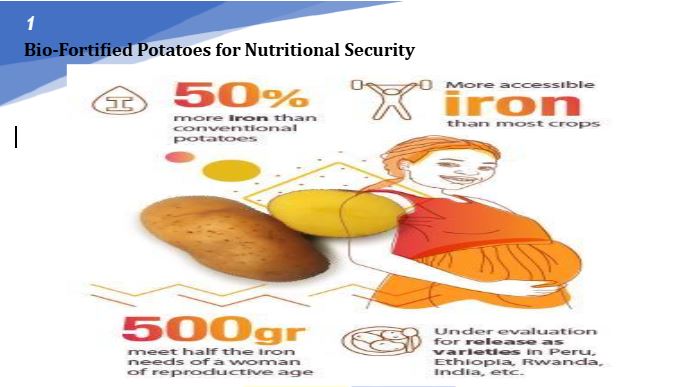Bio-Fortified Potatoes for Nutritional Security
Sat Aug 23, 2025
Why in News?
India plans to introduce iron-rich bio-fortified potato varieties developed by the International Potato Center (CIP), Peru, to address iron-deficiency anemia and hidden hunger.
- CIP has shared the germplasm with ICAR-CPRI, Shimla for adaptation to Indian agro-climatic zones.
- The CIP-South Asia Regional Centre is being set up in Agra, backed by ₹111.5 crore approval from the Indian government, positioning UP as a regional hub for tuber crop innovation.

What Is It ?
Bio-fortified potatoes are conventionally bred varieties enriched with higher iron content, developed without altering yield, taste, or agronomic traits.
- The iron present is highly bioavailable: studies suggest uptake of ~30% by women, and in high-consumption regions potatoes could meet up to 50% of daily iron requirement.
The News
- A Peruvian high-iron potato variety has been released and is now under evaluation in India by ICAR-CPRI for suitability across diverse agro-climatic zones.
- Vitamin A–bio-fortified sweet potatoes are already deployed in states like Karnataka, Assam, West Bengal, and Odisha.
- CIP’s Agra centre aims to facilitate seed distribution, farmer training, germplasm conservation, and regional R&D.
Analysis
- Nutritional Relevance: Iron deficiency anemia affects ~57% of women and
>67% of children as per NFHS-5. Potatoes are staple crops, offering a vehicle for micronutrient delivery.
- Agricultural Edge: Potatoes are India’s second-largest crop, esp. across the Indo-Gangetic Plains. Improved seed varieties can raise productivity, reduce input costs, and enhance farmers’ incomes.
- Integration Opportunity: Bio-fortified potatoes can be leveraged in public nutrition schemes (e.g. mid-day meals), aligning with missions like POSHAN Abhiyaan and Eat Right India.
Challenges & Limitations
- Adaptation: Imported germplasm requires rigorous evaluation for India’s varied climates and pest resistance norms.
- Scaling Seeds: Infrastructure gaps exist in quality seed production and timely distribution, especially to smallholders.
- Acceptance: Dietary shifts and farmer adoption depend on taste, yield, and storage performance comparable to local varieties.
- Nutrient Interference: Iron bioavailability may be affected by soil conditions, cooking methods, and anti-nutrient factors depending on agronomic practices.
Future Prospects
- Regional Innovation Hub: CIP’s Agra Centre will enable localized breeding, training, and cross-border cooperation for South Asia.
- Scaling Biofortified Varieties: Post trials, these potatoes can be integrated into food procurement systems, nutrition schemes, and processing industries.
- Broader Crop Biofortification: India has released 61 biofortified varieties across 34 field crops and 27 horticultural crops.
- Nutrition-Agri Convergence: Potential to expand to zinc, vitamin A, and other micronutrient-enriched staples.

UPSC Prelims MCQ
With reference to bio-fortified potatoes being introduced in India, consider the following statements:
- These potatoes are developed through conventional breeding and biotechnology without using transgenic techniques.
- India’s regulatory regime requires mandatory safety assessment and labeling for all bio-fortified crops regardless of method used.
4
- Seed distribution for bio-fortified varieties in India is supported under the Krishi Vigyan Kendra and RKVY programmes.
Which of the statements given above are correct?
- 1 and 2 only
- 1 and 3 only
- 2 and 3 only
- All three
Correct Answer: B. 1 and 3 only Explanation:
Statement 1: Correct The iron-rich bio-fortified potatoes introduced in India are developed using conventional breeding and non-transgenic biotechnological methods, without using genetic modification techniques, thereby avoiding GM regulatory complexity. These maintain taste and yield traits.
Statement 2: Incorrect Bio-fortified crops developed through non-GM breeding methods do not require the same extensive regulatory scrutiny, mandatory safety assessment, or labeling as GM crops under India’s GEAC/FSSAI norms. Regulatory hurdles typically apply to genetically engineered variants, not conventional bio-fortified lines.
Statement 3: CorrectIndia leverages existing agricultural infrastructure—such as Krishi Vigyan Kendras (KVKs) and schemes like Rashtriya Krishi Vikas Yojana (RKVY)—to promote bio-fortified seed distribution, farmer training and extension activities. These channels are key for scaling adoption in rural and tribal districts.

